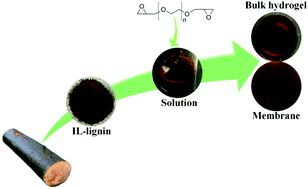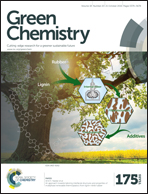Preparation and comparison of bulk and membrane hydrogels based on Kraft- and ionic-liquid-isolated lignins†
Abstract
Lignin obtained from two different sources, from the Kraft process (KF-lignin) and from dissolution of wood using ionic liquid (IL-lignin), was dissolved in alkaline solution and crosslinked with different methods, attempting to form bulk and membrane hydrogels. Without a chemical crosslinker, no physical lignin gels could be formed. When employing three different chemically crosslinking routes, epichlorohydrin (ECH), polyethylene glycol (PEG)/ECH, and epoxide-terminated PEG (ETPEG), only the third route produced “hydrogels” with excellent water absorbency. To form a hydrogel, lower IL-lignin concentration (15 wt%) was needed than for KF-lignin (20 wt%). Once air-dried, both of the dense lignin/ETPEG gels showed comparable high tensile strength, independent of the type of lignin. However, while in the wet state, the IL-lignin/ETPEG hydrogels were much stronger than those from KF-lignin, thus facilitating their preparation and utilization. High water uptake was observed for all lignin/ETPEG gels, although a smaller swelling was observed with IL-lignin gels. Additionally, water vapor transmission (WVT), antioxidant efficiency, and antimicrobial activity of the membranes were determined and these data suggest their potential application as food packaging or wound dressing materials, especially for the IL-lignin membranes considering their easier formation, higher WVT, antioxidant efficiency, and wet strength.


 Please wait while we load your content...
Please wait while we load your content...